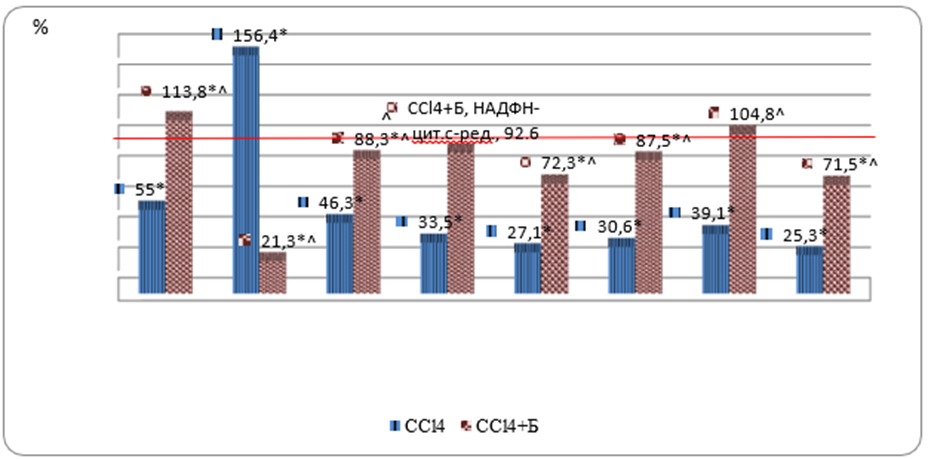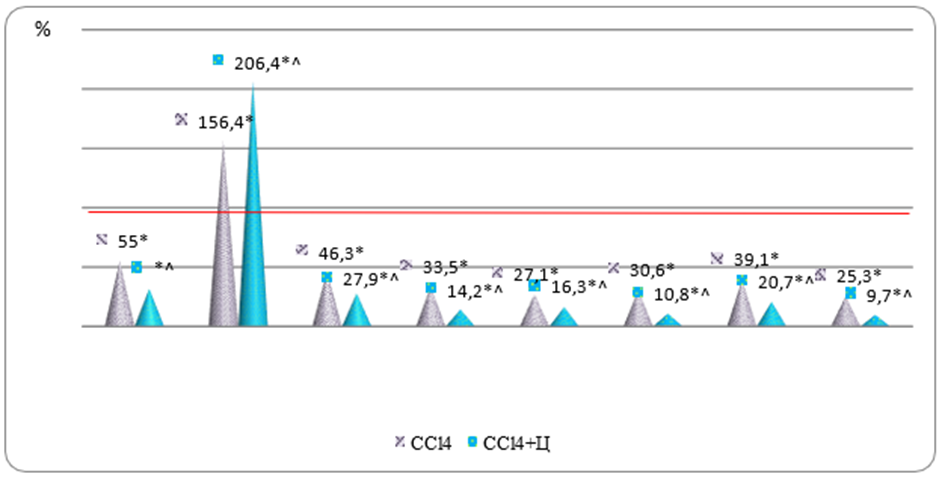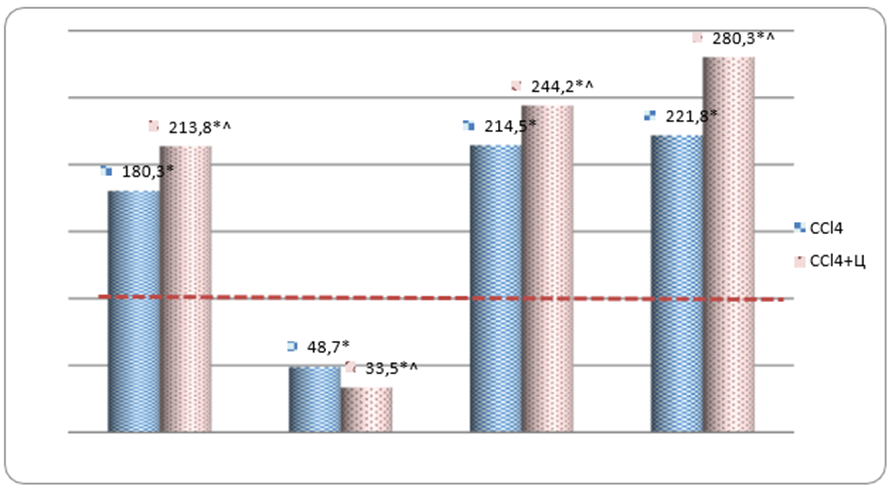Research Article
Activity of Monooxygenase and Nitrogenous Systems in Liver Microsomes under the Influence of Inducers and Inhibitors of Medicinal Metabolism on the Organism in Conditions of Liver Pathology
1Central Scientific Research Laboratory at the Tashkent Medical Republic of Uzbekistan Academy, Uzbekistan.
2Head of the Department of General and Pediatric Surgery of the Tashkent Medical Academy. Republic of Uzbekistan.
3Central Scientific Research Laboratory at the Tashkent Medical Academy, Republic of Uzbekistan.
*Corresponding Author: Sayfullaeva Saida, Central Scientific Research Laboratory at the Tashkent Medical Republic of Uzbekistan Academy, Uzbekistan.
Citation: S Saida, O Alisher, J Nargiza. (2024). Activity of Monooxygenase and Nitrogenous Systems in Liver Microsomes Under the Influence of Inducers and Inhibitors of Medicinal Metabolism on the Organism in Conditions of Liver Pathology. Journal of Clinical Psychology and Mental Health, BioRes Scientia Publishers. 3(1):1-5. DOI: 10.59657/2993-0227.brs.24.015
Copyright: © 2024 Sayfullaeva Saida, this is an open-access article distributed under the terms of the Creative Commons Attribution License, which permits unrestricted use, distribution, and reproduction in any medium, provided the original author and source are credited.
Received: December 12, 2023 | Accepted: February 28, 2024 | Published: February 10, 2024
Abstract
In experiments on 48 white-breed rats of males with a mass of 180-250 g. it was found that benzonal in an effective dose of 75 mg/kg had a favourable effect on the monooxygenase and nitration system of hepatocyte microcircuits of rats with acute liver damage, while cimetidine in a dose of 10 mg/kg further suppressed the activity of MCO, increased the formation of toxic radicals NO, leading to an even greater aggravation of the severity of the animals.
Keywords: monooxygenase; NO-system; benzonal; cimethedrine; hepatitis; nitrogen oxide; endothelial nitric oxide synthase; inducible nitrogen oxide synthase; peroxynitrite; cytochrome P450
Introduction
In recent years, researchers have shown interest in intersystem and interorgan interrelations at the level of cellular activity, especially in the organs responsible for the functioning of the entire organism, maintaining its homeostasis in various pathological situations that arise both inside the organism and against the background of external causes [2,23]. Because of the special structurally functional position and liver value, hepatocytes occupy a special place, because their functioning is constantly influenced by endogenously formed and exogenously incoming xenobiotics [19, 21]. Liver parenchyma has the ability to level out all these threats. Functional activity of hepatocytes is determined by the solvency of enzymes of the monooxygenase system [16,17]. Physiological stability and flexible adaptability of this system can be fully assessed and traced against the background of the use of inducers or inhibitors of drug metabolism. It has been proved that the former increases the activity of monoxygenases, while the latter, on the contrary, reduce their activity [18,20]. However, there is still no answer to the question of how monoxygenase inducers and inhibitors influence the activity of the nitragic system. It is already known that the last markers of activity are nitrogen oxide (NO), endothelial (eNOS) and inducible NOS (iNOS) NO-synthase and peroxynitrite (ONO2-) [9,10].
The aim of the study is to study the activity of monooxygenases and NO-system parameters in microsomes of hepatocytes against the background of the action of benzonal inductor and cimethydine inhibitor in the conditions of liver pathology.
Material and Methods
The studies were carried out on 48 white, non-pedigree male rats weighing 180-250 g, which were divided into groups depending on the conditions of the experiment. The first group was the group of animals, which were intragastricly injected with 1% aqueous suspension of benzonal in doses of 75 mg/kg within 6 days, the second group was the group of animals, which were intragastric injected with 1% aqueous solution of cimetidine in dose of 10 mg/kg. Control for all groups - intact animals (8 individuals in each group). The animals were kept under standard vivarium and diet conditions. The experimental rats underneath the raush narcosis were slaughtered by instantaneous guillotine decapitation. The content of cytochromes P-450, P-420 and b5 by S method was determined in 105 000g of microsomal fractions of hepatocytes isolated with the help of preparative ultracentrifuge VAC 601 (Germany) on bovine spectrophotometer UV-2100 (Ltd, China). Omura and R. Sato (1964), activity of microsomal enzymes: HADP c-reductase was evaluated by C.H. Williams, H.Kamin (1961), benz(a)pyrengidroxylaze (B(a)PG) by C.H.Yang, L.P.Kicha (1978), N-demethylase amidopirine (N-AP) by A.Bast, J. Nordhosck (1981), anilingidroxylaze (AG) by A.I. Archakov et al. (1975), glucose-6-phosphatases (G-6-phases) - by N.S. Gnosh, N.S. Kar (1963). At the same time in the isolated microsomes the content of NO was determined by its main stable metabolites - ONO2- and ONO3- by P.P. Golikov et al. (2000), the activity of eNOS and iNOS was evaluated by V.V. Sumbayev, I.M. Yasinskaya (2000), concentration of ONO2- - according to the method of A.S. Komarin, R.K. Azimov (2005). Protein in microsomes was determined by O.N. Lowry and coauth method. (1951).
The obtained data were processed by the method of variation statistics. The results satisfying p<0>
Results and Discussion
As liver pathology, we used the CCl4induced OTG model. We observed a decrease in the content and suppression of the activity of the enzymes of the MCO (Table 1). Thus, in rats with OTH caused by the introduction of CCl4, the content of cytochrome P-450 and b5 decreased significantly in 1.83 (P<0>
Indicators of the nitrgic function of hepatocyte microcircuits were characterized by sharp inhibition of eNOS (decrease up to 48.7% relative to the initial parameters) and induction of the inducible form of nitrogen oxide synthase (increase up to 214.3% of the initial level) when using the model of liver damage with tetrachloromethane.
Nitric oxide and peroxynitrite levels increased statistically by 1.8 (P<0>
Table 1: Indicators of the nitriergic system in rat liver microsomes at its toxic lesions, M±m, n=6=7
| Groups | Nitrogen system | |||
| NO, µmol/mg protein | eNOS, µmol/min/mg protein | iNOS, µmol/min/mg protein | -ONO2, µmol/mg protein | |
| ОТГ, CCl4 | 9,95±0,317* | 8,48±0,306* | 0,21±0,010* | 0,18±0,007* |
| Control | 5,52±0,164 | 17,42±0,627 | 0,10±0,002 | 0,080±0,0016 |
Note: *differences between intact and experimental groups are reliable: p<0>
Therefore, in liver lesions, regardless of their genesis, the activity of hepatocytes MCO is significantly suppressed, and the inducible nitrgic enzyme system is sharply activated, significantly increasing the formation of toxic products of nitrogen oxide metabolism. Of particular interest to us were the effects of the benzene in animals with OTG on the activity of the nitrogenous system. Benzonal was studied in an effective dose of 75 mg/kg, which was administered intragastricly for 6 days a day. The conducted studies showed that the benzonal inductor increases the activity of MCO enzymes in animals with CBF caused by tetrachloromethane (Fig. 1). Thus, the content of cytochromes P-450 and b5 increased statistically significantly in 2.07 (P<0>
Figure 2: Influence of benzonal on the liver microsystem in rats with OTG caused by tetrachloromethane administration.
Note: *-P<0>
Consequently, benzonal activates the MCO of rat liver lesions, slightly reducing the imbalance in the nitrogen oxide production system. We have not revealed any recovery of the nitrigenous system. The next stage of our studies was the study of the influence of cimetidine on the indices of monooxygenase and nitrgic systems of hepatocytes at acute toxic liver damage. Thus, cimetidine inhibitor in the dose of 10 mg/kg (less toxic dose) further suppressed the activity of MCO enzymes in animals with OTG caused by tetrachloromethane (Fig. 3). Thus, the content of cytochrome P-450 and b5 statistically significantly decreased by 1.73 (P<0>
Figure 3: Content of cytochromes and activity of monooxygenase enzymes in the liver of rats with OTH caused by tetrachloromethane administration against the background of cimetidine(C) application.
Note: *-P<0>
Therefore, the use of cimetidine in liver damage is not appropriate, as it further blocks the work of MCO hepatocytes. Evaluation of the efficacy of cimetidine use in rats with liver damage in the correction of liver microsystem disorders has shown an even greater aggravation of the existing disorders. Thus, in rats with OTH caused by administration of tetrachloromethane, high activity of the inducible form of nitric oxide synthase after administration of cimethydine increased even more (1.14 times), low activity of eNOS decreased further (1.45 (P<0>
Figure 4: Influence of cimetidine on liver microsystem parameters in rats with OTH caused by tetrachloromethane administration.
Note: *-P<0>
Therefore, the use of MCO inhibitor in liver diseases further aggravates the existing abnormalities in the nitragmatic systems of hepatocyte microcircuits. Thus, the classic inhibitor of cimetidine drug metabolism suppresses the activity of liver MCO and has an inducing effect on the activity of iNOS, increases the formation of toxic nitrogen oxide radicals, which can lead to further aggravation of the condition of patients with liver diseases.
Conclusion
Thus, the reaction of monooxygenase enzymes and NOS in microsomes under the action of a benzonal inductor is manifested in the synchronous mode of its intensification. Under the action of the inhibitor of the cimethydine monooxygenase system, the suppression of the rate of monooxygenase reactions is characterized by an increase in the activity of NOS both due to its constitutive (eNOS) and unconstitutional (iNOS) with simultaneous increase in the content of NO and ONO2- in microsomes. The revealed correlations between the indices of monooxygenase system and NOS testify to their clear mutual functional dependence, which, unfortunately, is still not taken into account in the experimental and clinical pharmacology, as well as in the treatment of patients who are prescribed inducers and inhibitors of drug metabolism.
Conclusions: In animals with OTG (CCl4), a benzonal dose of 75 mg/kg stimulating liver MCO, along with an increase in MCO enzymes, the activity of eNOS, simultaneously initiates the formation of NO, iNOS activity and the amount of ONO2.
The effective inhibitory dose of cimetidine 10 mg/kg potentiates the toxic effect of OTH, aimed at reducing both all the parameters of MCO and oppression of eNOS, expression NO, iNOS and ONO2.
References
- A.I. Archakov, A.V. Lisitsa, N.A. Petushkova, I.I. Karuzina. (2008). R-450 cytochrome, medicinal disease and personalized medicine.Klin. med. p. 4-8.
Publisher | Google Scholor - Vanin, A.F. (2001). Nitrogen oxide - regulator of the cellular metabolism (in Russian) // Sorosovsky obrazovatelnogo zhurnal (in Russian) pp. 7-12.
Publisher | Google Scholor - Zinchuk, V.V. (2009). Endothelial dysfunction and oxygen-binding properties of hemoglobin. Cardiology. 7-8. pp. 81-89.
Publisher | Google Scholor - Inzhutova A.I, Larionov A.A., Petrova M.M., Salmin A.B. (2001). The theory of intercellular communication in the endothelial dysfunction development (in Russian) Bulletin of Biol. and Med. pp. 165-170.
Publisher | Google Scholor - Kukes V.G., Sychev D.A. Hasanov, N.A. (2007). Problems of clinical pharmacokinetics at the present stage (in Russian) Klin. pp. 58-63.
Publisher | Google Scholor - Kukes V.G., Sychev D.A., Shikh E.V. (2007). Biotransformation study of the medicinal products is a way to increase the efficiency and safety of the pharmacotherapy (in Russian) Doctor. pp. 2-5.
Publisher | Google Scholor - Lukyanova, L.D. (2007). The role of the bioenergetical disorders in the pathogenesis of hypoxia Pat.pp. 2-11.
Publisher | Google Scholor - Lukyanova L.D., Dudchenko A.M., Tsybina T.A., Germanova E.L. (2007). Regulatory role of mitochondrial dysfunction in hypoxia and its interaction with transcription activity. MPEI Vestnik. RAMS. pp. 3-13.
Publisher | Google Scholor - Lyakhovich V.V., Vavilin V.A., Zenkov N.K., Menschikova E.B. (2005). Activated oxygen metabolites in the monoxygenase reactions Bul. SO RAMS. pp. 7-12.
Publisher | Google Scholor - Manukhina E.B., Downey H.F., Mallet R.T., Menshev I.Yu. (2007). Protective and damaging effects of the periodic hypoxia: the role of nitrogen oxide MPEI Vestnik. RAMS. pp. 25-33.
Publisher | Google Scholor - Markov, H.M. (2005). Molecular mechanisms of vascular endothelial dysfunction Cardiology. pp. 62-72.
Publisher | Google Scholor - Moiseyev S.V. (2005). Medicinal hepatotoxicity Klin. 14 (1). pp. 10-14.
Publisher | Google Scholor - Osipov A.N., Borisenko G.G., Vladimirov Yu.A. (2007). Biological role of nitrosyl complexes of hemoproteins. Successes of biol. Т. 47. - pp. 259-292.
Publisher | Google Scholor - Pokrovskiy, V.I., Vinogradov, N.A. Nitrogen oxide, its physiological and pathophysiological properties. Ter. pp. 82-87.
Publisher | Google Scholor - Rice, R.H., Gulyaeva, L.F. (2003). Biological effects of the toxic compounds. Novosibirsk. p.208.
Publisher | Google Scholor - Saratikov A.S., Novozheeva T.P., Vengerovskiy, A.I. (2003). Efficiency of the fermenting agents at the experimental liver damage with tetrachloromethanol Expert and clin. pp. 48-49.
Publisher | Google Scholor - Sivkov A.S., Paukov S.V., Ruvinov Yu.V., Kukes I.V. (2010). Individual safety of pharmacotherapy when evaluating the activity of cytochrome P-450 3A4 isoenzyme (CYP3A4) Klin. med. pp. 61- 067.
Publisher | Google Scholor - Simon V.A., Cytochrome V.A. (2002). R-450 and interaction of the medicinal substances Ros. zhurn. gastroenterol, hepatol., koloproktol. pp. 25-30.
Publisher | Google Scholor - Durante W., Johnson F.K., Johnson R.A. (2007). Arginase: a critical regulator of nitric oxide synthesis and vascular function. Clin. Exp. Pharmacol. Pgysiol. Vol. 34, pp. 906-911.
Publisher | Google Scholor - Getz G.S. (2006). Argenine/Arginase NO Arteriosclerosis, Thrombosis and Vascular. Biol. Vol. 26. - pp. 237-240.
Publisher | Google Scholor - Kuczeriszka M., Olszynski K.H., Gasioroeska A. et al. (2011). Interaction of nitric oxide and the cutochrome P-450 system on blood pressure and renal function in the rat: dependence on sodium intake. Acta Pgysiologica. Vol. 201, pp. 493-502.
Publisher | Google Scholor - Lee W. (2003). Drug-induced hepatotoxicity New Engl. J. Med. Vol. 349.pp. 474-485.
Publisher | Google Scholor - Minamiyama Y., Jmaoka S., Takemura S. et al. (2001). Escape from tolerance of organic Nitrite by induction of cytochrome P450 Free Radical Biology et Medicine. Vol. 31, pp. 1498-1508.
Publisher | Google Scholor

















